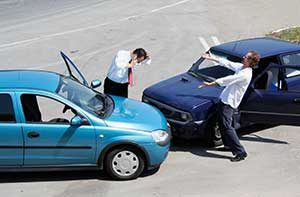Most drivers do, at one time or another, drive while drowsy. Whether it’s a late road trip coming home from holiday fun or just another late night at the office, drowsy driving happens all the time. Drowsy driving doesn’t just affect a driver’s ability to stay on the road, but it can also affect reaction time and a driver’s ability to make good decisions. Unfortunately, there is no way to test for drowsy driving beforehand – or prevent it, unless drivers become more aware of how tired they are when they start to drive.
RI sleepy driving car accident attorney

According to the National Highway Traffic Safety Administration (NHTSA), “72,000 crashes, 44,000 injuries, and 800 deaths in 2013” were likely caused by drowsy driving. These are estimated numbers, however, and are likely to be much higher as many accidents that occur are not recorded as being caused by a drowsy driving.
The biggest risk for drowsy driving is, of course, sleep deprivation, but other factors are common, including: Drowsy Driving.CDC
- According to Drowsy Driving, shift workers who work at night are more likely to drive drowsy than daytime workers.
- Adults who have children are also more likely to drive drowsy than those without children.
- “Those with undiagnosed sleep disorders such as acute insomnia or sleep apnea have a higher risk of being involved in a sleep-related accident,” according to Drowsy Driving.
- “A study by researchers in Australia showed that being awake for 18 hours produced an impairment equal to a blood alcohol concentration (BAC) of .05, and .10 after 24 hours; .08 is considered legally drunk,” according to Drowsy Driving.
- In addition, most crashes and near misses occur between the hours of 4:00 and 6:00 a.m., followed closely by midnight and 2:00 a.m., according to the CDC.
East Providence injury lawyers
Everyone gets tired, but it’s important to recognize the signs that you might be too tired to drive. The best way to prevent drowsy driving is to get enough sleep. Every adult needs seven hours or more every night. This is crucial to functioning well in any aspect of your life – not just driving. You’ll feel better too. If you think you might have a sleep disorder of some type, consult a physician. While driving, if you find yourself yawning or blinking a lot, you should probably pull over and get some rest. Likewise, if you realize you can’t remember the last few miles of road or you miss a turn-off, you may be too drowsy to drive.
Tired, sleepy and drowsy driving- falling asleep at the wheel
“The consequences of fatigue on human performance can be subtle. Fatigue is both a symptom of poor sleep and health management and an enabler of risky behavior, such as poor judgment and decision making, slowed reaction times, and loss of situational awareness and control. Fatigue degrades a person’s ability to stay awake, alert, and attentive to the demands of controlling their vehicle safely. Drivers may not recognize the effects of fatigue until it is too late. The traveling public can unknowingly and unwillingly be placed at risk because a fatigued operator cannot safely execute his or her duty. According to the National Highway Traffic Safety Administration, from 2009 to 2013, more than 72,000 police-reported crashes involved drowsy drivers, and resulted in more than 41,000 injuries and more than 800 deaths. Another study conducted in 2014 by the AAA Foundation for Traffic Safety estimated that as many as one in five fatal crashes involve drowsy driving. Additionally, a recent AAA survey found that more than 31 percent of highway vehicle drivers admitted driving while so tired that they had trouble keeping their eyes open.” National Transportation Safety Board (NTSB) , Reduce Fatigue-Related Accidents
fall asleep at the wheel
One of the hidden risks of driving is that either you or another driver on the road nearby could fall asleep at the wheel, and in an instant your life could take a turn for the worst, whether it be a major injury or even loss of life. In fact, experts say that drowsy driving is just as dangerous as drunk driving. Drowsy drivers have more difficulty paying attention to the road and reacting when they need to slow down or stop suddenly.
6,000 fatal crashes each year
According to the U. S. National Highway Traffic Safety Administration (NHTSA), drowsy driving causes at least 100,000 crashes per year in which about 40,000 individuals are hurt and 1,500 die. However, experts at the NHTSA believe that the actual numbers of injuries and deaths are much higher—up to 6,000 fatal crashes each year. It is very difficult to confirm that an accident was caused by someone falling asleep while driving because there is no test like with drunk driving.
Who Is Most At Risk?
We are all at risk, but there are a few characteristics that tend to lead to drowsy driving. First, be aware that we are typically more tired between midnight and 6 a.m. or in the late-afternoon since these are the times when we experience dips in our circadian rhythm (our body’s internal clock that regulates sleep). Single drivers are more likely to fall asleep at the wheel since they have no one to help keep them alert. Next, shift workers and commercial truck drivers are most likely to drive drowsy given their poor sleep habits. Finally, drivers with untreated sleep disorders like sleep apnea are at greater risk.
Know The Warning Signs
All drivers need to be aware of the signs that they may be getting too tired to continue driving. The United States Centers for Disease Control points out the following key warning signs to watch out for:
- Yawning often
- Unable to keep eyes open
- Trouble keeping your head up
- Difficulty remembering the past few miles driven
- Missing road signs or turns
- Drifting into other lanes or onto rumble strips on the shoulder
- Ending up too close to cars in front of you
If you experience any of these warning signs, either switch drivers or pull over and find a safe place to rest.
How To Prevent Drowsy Driving
Falling asleep while driving is completely preventable if you take the following precautions:
- Get a restful night’s sleep—7 or 8 hours each night. Do this by creating good sleep hygiene habits, including low intensity exercise before bed, as well as other relaxation and hygiene rituals.
- Try not to drive late at night.
- Avoid driving alone. On a long trip, share the driving with another passenger.
- Avoid ineffective tricks like smoking, listening to loud music, drinking caffeinated beverages, or opening a window. These are not real cures for drowsiness.
- Address any sleep disorders by seeing a physician about treatment options.
- Do not take medications that can make you sleepy, such as narcotic pain pills, tranquilizers, cold or cough medicine, muscle relaxants, some antidepressants, some high blood-pressure pills, and some antihistamines.
- Avoid drinking any alcohol before driving.
If each of us follows these tips, our roads will be safer for everyone.
Tiredness, drowsiness, and sleepiness are significant contributors to car accidents. When a driver is fatigued, their reaction times, decision-making abilities, and overall alertness can be impaired, increasing the risk of accidents. Here are some key points related to tiredness and car accidents:
- Impaired Reaction Times: Fatigue can slow down a driver’s reaction times. In a critical situation on the road, a drowsy or tired driver may not be able to respond quickly enough to avoid an accident.
- Reduced Alertness: Fatigue can cause a driver to become less alert and attentive. This can lead to lapses in concentration and awareness, making it more likely for them to miss important road signs, signals, or hazards.
- Microsleeps: Drowsy drivers may experience brief episodes of “microsleeps” lasting only a few seconds. During a microsleep, the driver is effectively asleep and unaware of their surroundings, which can be extremely dangerous when operating a vehicle.
- Impaired Decision-Making: Tired drivers may make poor decisions or misjudge situations on the road due to impaired cognitive function. This can lead to risky behaviors, such as aggressive driving or failing to yield the right of way.
- Increased Risk at Night: Fatigue-related accidents are more common at night when the body’s natural circadian rhythms make people naturally drowsier.
To prevent accidents related to fatigue and drowsiness, it’s essential to:
- Get Adequate Sleep: Ensure you are well-rested before driving, especially for long trips. Aim for 7-9 hours of sleep per night.
- Take Breaks: On long journeys, take regular breaks to rest, stretch, and refresh. Avoid driving for extended periods without breaks.
- Avoid Driving at High-Risk Times: If possible, avoid driving during the hours when you are naturally drowsy, such as late at night or in the early afternoon.
- Share the Driving: If you’re on a long trip with others, take turns driving to reduce fatigue.
- Recognize Warning Signs: Be aware of the signs of fatigue, such as yawning, heavy eyelids, drifting out of your lane, or difficulty maintaining speed. If you experience these symptoms, pull over to a safe location and rest.
It’s crucial to prioritize safety on the road, and that includes being well-rested and alert when you’re behind the wheel. Drowsy driving can have severe consequences, so taking steps to prevent it is essential for your safety and the safety of others on the road. If you are in a car accident or injured by a driver that may have been drowsy, you should consult a Rhode Island injury attorney or a RI personal injury lawyer.
